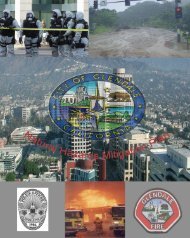Sayre Report - Hazard Mitigation Web Portal - State of California
Sayre Report - Hazard Mitigation Web Portal - State of California
Sayre Report - Hazard Mitigation Web Portal - State of California
Create successful ePaper yourself
Turn your PDF publications into a flip-book with our unique Google optimized e-Paper software.
potential for erosion are the silty clay and sandy loams with a low water (< 2<br />
in/hr). The Los Angeles County, West San Fernando area soil survey indicates<br />
the soils in the <strong>Sayre</strong> Fire are in the loam category and has a moderately high<br />
susceptibility to erosion and will produce moderate sediment flows.<br />
B. Describe Condition <strong>of</strong> Values at Risk<br />
Evaluations <strong>of</strong> the Los Angeles County Public Works Debris Basins indicate<br />
some initial signs <strong>of</strong> increased sediment load. Small amounts <strong>of</strong> sheet and rill<br />
erosion was observed in the local area surrounding the basins. During the onsite<br />
evaluation <strong>of</strong> the Sombrero debris basin, Los Angeles County Public Works<br />
was in the process <strong>of</strong> removing up to 13 feet <strong>of</strong> sediment that was reportedly<br />
produced during the post-fire storm event (11/25 and 11/26) <strong>of</strong> up to 2 inches <strong>of</strong><br />
rain. The topography in the local area <strong>of</strong> the basins ranged for 33 to 75% slope.<br />
Erosion, flooding and mudflows are considered naturally occurring phenomenon<br />
during pre-fire conditions. However, burn severity combined with slope<br />
steepness accelerates the process.<br />
The access road at the Pacoima Reservoir was reported to have had up to 3 feet<br />
<strong>of</strong> erosion sediment blocking the main access to the Dam. The sediment<br />
originated from the area adjacent to the road and was the result <strong>of</strong> recent Marek<br />
Fire (October 12, 2008).<br />
The six-foot box culvert under Gavina Avenue was observed to have up to tw<strong>of</strong>eet<br />
<strong>of</strong> sediment in the flow line <strong>of</strong> the structure. The amount <strong>of</strong> blockage is<br />
moderate at this time, but could easily become completely blocked if a<br />
combination <strong>of</strong> debris and sediment passed through the channel.(see hazard<br />
point in appendix 1)<br />
Multiple residential debris basins and small drainage areas behind a number <strong>of</strong><br />
homes were evaluated with minor to no erosion sediment observed from recent<br />
storm events.<br />
III.<br />
IV.<br />
Emergency Determination<br />
The Values at Risk considered in this soils assessment include the possible loss<br />
<strong>of</strong> life and property due to erosion sediment flow and flooding from increased<br />
surface water run<strong>of</strong>f. In general, there is a low risk <strong>of</strong> loss <strong>of</strong> life and moderate<br />
risk for loss <strong>of</strong> property due to increase run<strong>of</strong>f from a 4.1 - 4.7 inch – 24 hour rain<br />
event. In this case there is no Emergency action recommended for property and<br />
structures, but recommendations have been made for treatments and monitoring.<br />
.<br />
Discussion/Summary/Recommendations<br />
Landscape level erosion control treatments are impractical for treating the entire<br />
fire area, but mulching, fiber rolls, and straw bales with silt fencing may be used

















